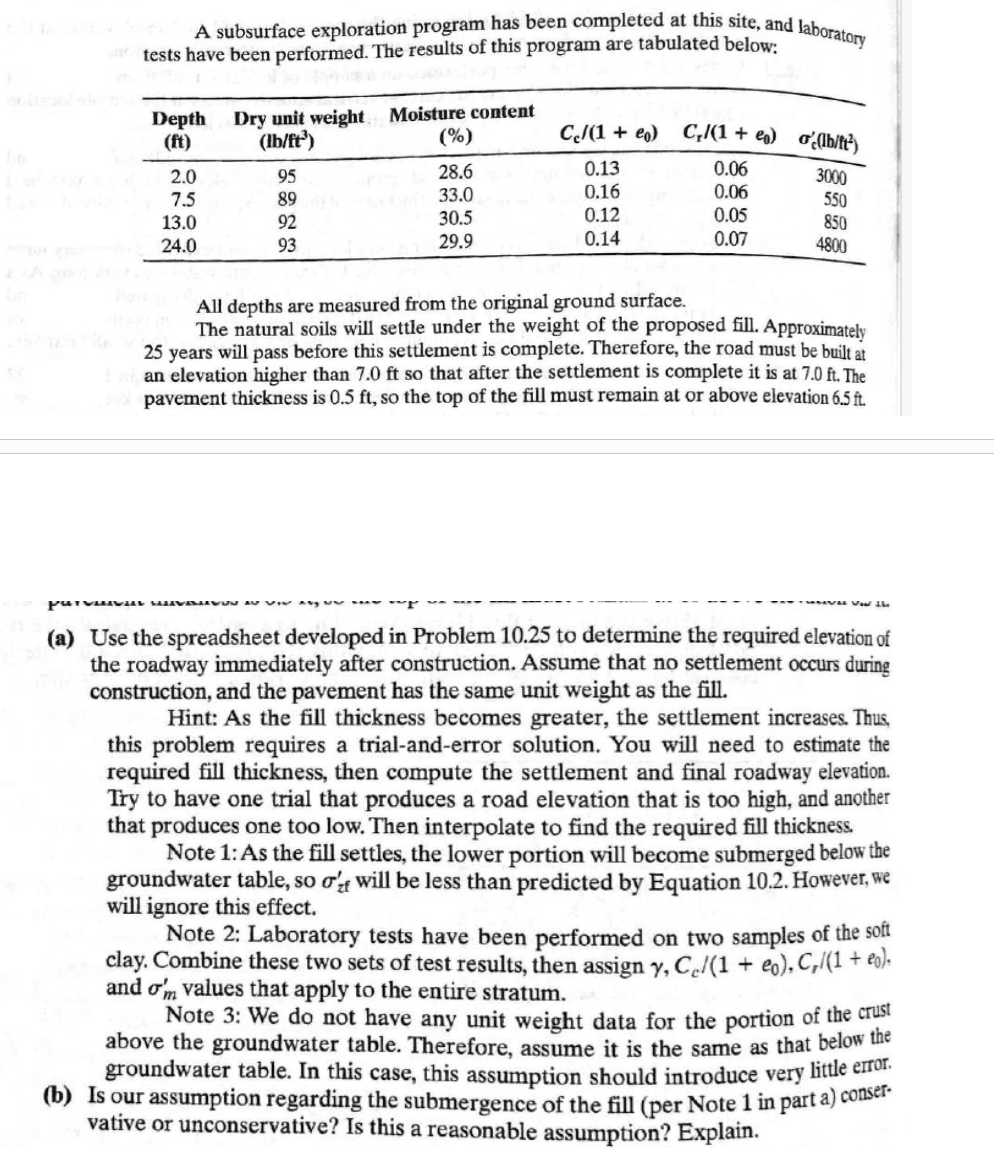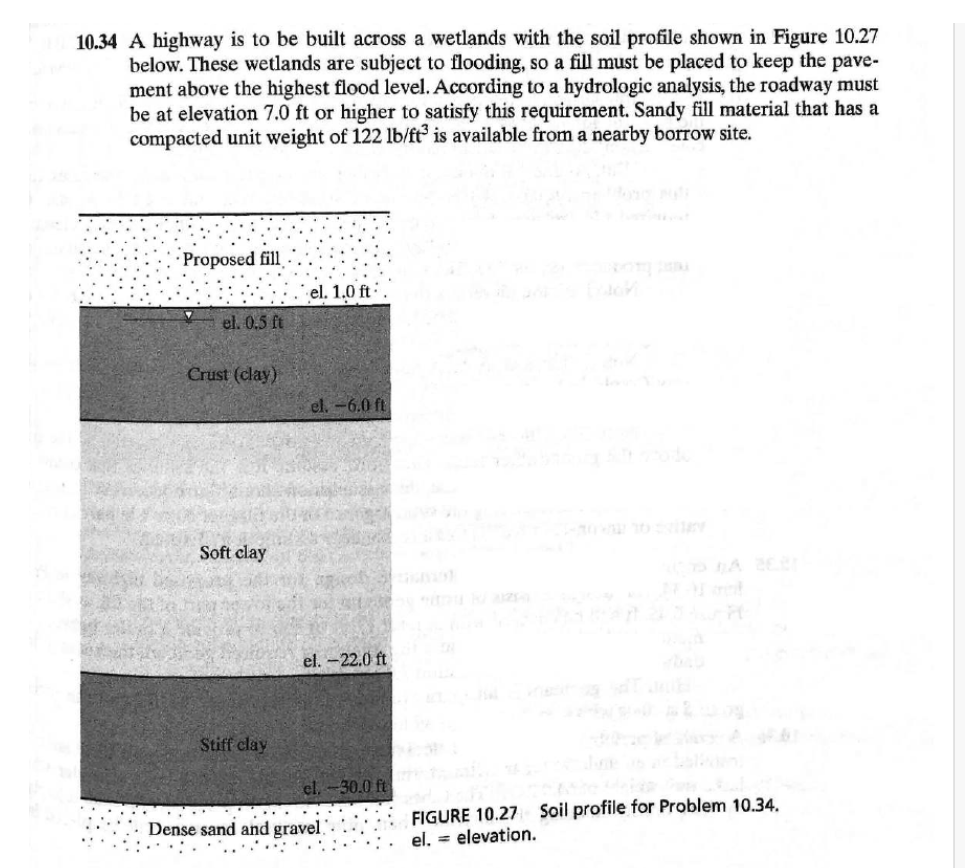A subsurface exploration program has been completed at this site, and laboratory tests have been performed. The results of this program are tabulated below: Depth Dry unit weight Moisture content (ft) (lb/ft³) (%) Cc/(1+eo) C/(1+) (lb/ft²) 2.0 95 28.6 0.13 0.06 3000 7.5 89 33.0 0.16 0.06 550 13.0 92 30.5 0.12 0.05 850 24.0 93 29.9 0.14 0.07 4800 All depths are measured from the original ground surface. The natural soils will settle under the weight of the proposed fill. Approximately 25 years will pass before this settlement is complete. Therefore, the road must be built at an elevation higher than 7.0 ft so that after the settlement is complete it is at 7.0 ft. The pavement thickness is 0.5 ft, so the top of the fill must remain at or above elevation 6.5 ft. V Vow the (a) Use the spreadsheet developed in Problem 10.25 to determine the required elevation of the roadway immediately after construction. Assume that no settlement occurs during construction, and the pavement has the same unit weight as the fill. Hint: As the fill thickness becomes greater, the settlement increases. Thus, this problem requires a trial-and-error solution. You will need to estimate the required fill thickness, then compute the settlement and final roadway elevation. Try to have one trial that produces a road elevation that is too high, and another that produces one too low. Then interpolate to find the required fill thickness. Note 1: As the fill settles, the lower portion will become submerged below the groundwater table, so σ' will be less than predicted by Equation 10.2. However, we will ignore this effect. Note 2: Laboratory tests have been performed on two samples of the soft clay. Combine these two sets of test results, then assign y, Ce/(1 + eo), C,/(1 + eo). and om values that apply to the entire stratum. Note 3: We do not have any unit weight data for the portion of the crust above the groundwater table. Therefore, assume it is the same as that below the groundwater table. In this case, this assumption should introduce very little error. (b) Is our assumption regarding the submergence of the fill (per Note 1 in part a) conser vative or unconservative? Is this a reasonable assumption? Explain. 10.34 A highway is to be built across a wetlands with the soil profile shown in Figure 10.27 below. These wetlands are subject to flooding, so a fill must be placed to keep the pave- ment above the highest flood level. According to a hydrologic analysis, the roadway must be at elevation 7.0 ft or higher to satisfy this requirement. Sandy fill material that has a compacted unit weight of 122 lb/ft³ is available from a nearby borrow site. ·Proposed fill el. 0.5 ft el. 1.0 ft Crust (clay) el.-6.0 ft Soft clay Stiff clay el.-22.0 ft A 2.2 el.-30.0 ft FIGURE 10.27 Soil profile for Problem 10.34. el. elevation. Dense sand and gravel.
A subsurface exploration program has been completed at this site, and laboratory tests have been performed. The results of this program are tabulated below: Depth Dry unit weight Moisture content (ft) (lb/ft³) (%) Cc/(1+eo) C/(1+) (lb/ft²) 2.0 95 28.6 0.13 0.06 3000 7.5 89 33.0 0.16 0.06 550 13.0 92 30.5 0.12 0.05 850 24.0 93 29.9 0.14 0.07 4800 All depths are measured from the original ground surface. The natural soils will settle under the weight of the proposed fill. Approximately 25 years will pass before this settlement is complete. Therefore, the road must be built at an elevation higher than 7.0 ft so that after the settlement is complete it is at 7.0 ft. The pavement thickness is 0.5 ft, so the top of the fill must remain at or above elevation 6.5 ft. V Vow the (a) Use the spreadsheet developed in Problem 10.25 to determine the required elevation of the roadway immediately after construction. Assume that no settlement occurs during construction, and the pavement has the same unit weight as the fill. Hint: As the fill thickness becomes greater, the settlement increases. Thus, this problem requires a trial-and-error solution. You will need to estimate the required fill thickness, then compute the settlement and final roadway elevation. Try to have one trial that produces a road elevation that is too high, and another that produces one too low. Then interpolate to find the required fill thickness. Note 1: As the fill settles, the lower portion will become submerged below the groundwater table, so σ' will be less than predicted by Equation 10.2. However, we will ignore this effect. Note 2: Laboratory tests have been performed on two samples of the soft clay. Combine these two sets of test results, then assign y, Ce/(1 + eo), C,/(1 + eo). and om values that apply to the entire stratum. Note 3: We do not have any unit weight data for the portion of the crust above the groundwater table. Therefore, assume it is the same as that below the groundwater table. In this case, this assumption should introduce very little error. (b) Is our assumption regarding the submergence of the fill (per Note 1 in part a) conser vative or unconservative? Is this a reasonable assumption? Explain. 10.34 A highway is to be built across a wetlands with the soil profile shown in Figure 10.27 below. These wetlands are subject to flooding, so a fill must be placed to keep the pave- ment above the highest flood level. According to a hydrologic analysis, the roadway must be at elevation 7.0 ft or higher to satisfy this requirement. Sandy fill material that has a compacted unit weight of 122 lb/ft³ is available from a nearby borrow site. ·Proposed fill el. 0.5 ft el. 1.0 ft Crust (clay) el.-6.0 ft Soft clay Stiff clay el.-22.0 ft A 2.2 el.-30.0 ft FIGURE 10.27 Soil profile for Problem 10.34. el. elevation. Dense sand and gravel.
Chapter2: Loads On Structures
Section: Chapter Questions
Problem 1P
Related questions
Question

Transcribed Image Text:A subsurface exploration program has been completed at this site, and laboratory
tests have been performed. The results of this program are tabulated below:
Depth
Dry unit weight Moisture content
(ft)
(lb/ft³)
(%)
Cc/(1+eo) C/(1+) (lb/ft²)
2.0
95
28.6
0.13
0.06
3000
7.5
89
33.0
0.16
0.06
550
13.0
92
30.5
0.12
0.05
850
24.0
93
29.9
0.14
0.07
4800
All depths are measured from the original ground surface.
The natural soils will settle under the weight of the proposed fill. Approximately
25 years will pass before this settlement is complete. Therefore, the road must be built at
an elevation higher than 7.0 ft so that after the settlement is complete it is at 7.0 ft. The
pavement thickness is 0.5 ft, so the top of the fill must remain at or above elevation 6.5 ft.
V Vow the
(a) Use the spreadsheet developed in Problem 10.25 to determine the required elevation of
the roadway immediately after construction. Assume that no settlement occurs during
construction, and the pavement has the same unit weight as the fill.
Hint: As the fill thickness becomes greater, the settlement increases. Thus,
this problem requires a trial-and-error solution. You will need to estimate the
required fill thickness, then compute the settlement and final roadway elevation.
Try to have one trial that produces a road elevation that is too high, and another
that produces one too low. Then interpolate to find the required fill thickness.
Note 1: As the fill settles, the lower portion will become submerged below the
groundwater table, so σ' will be less than predicted by Equation 10.2. However, we
will ignore this effect.
Note 2: Laboratory tests have been performed on two samples of the soft
clay. Combine these two sets of test results, then assign y, Ce/(1 + eo), C,/(1 + eo).
and om values that apply to the entire stratum.
Note 3: We do not have any unit weight data for the portion of the crust
above the groundwater table. Therefore, assume it is the same as that below the
groundwater table. In this case, this assumption should introduce very little error.
(b) Is our assumption regarding the submergence of the fill (per Note 1 in part a) conser
vative or unconservative? Is this a reasonable assumption? Explain.

Transcribed Image Text:10.34 A highway is to be built across a wetlands with the soil profile shown in Figure 10.27
below. These wetlands are subject to flooding, so a fill must be placed to keep the pave-
ment above the highest flood level. According to a hydrologic analysis, the roadway must
be at elevation 7.0 ft or higher to satisfy this requirement. Sandy fill material that has a
compacted unit weight of 122 lb/ft³ is available from a nearby borrow site.
·Proposed fill
el. 0.5 ft
el. 1.0 ft
Crust (clay)
el.-6.0 ft
Soft clay
Stiff clay
el.-22.0 ft
A 2.2
el.-30.0 ft
FIGURE 10.27 Soil profile for Problem 10.34.
el. elevation.
Dense sand and gravel.
Expert Solution
This question has been solved!
Explore an expertly crafted, step-by-step solution for a thorough understanding of key concepts.
Step by step
Solved in 2 steps with 3 images

Recommended textbooks for you


Structural Analysis (10th Edition)
Civil Engineering
ISBN:
9780134610672
Author:
Russell C. Hibbeler
Publisher:
PEARSON

Principles of Foundation Engineering (MindTap Cou…
Civil Engineering
ISBN:
9781337705028
Author:
Braja M. Das, Nagaratnam Sivakugan
Publisher:
Cengage Learning


Structural Analysis (10th Edition)
Civil Engineering
ISBN:
9780134610672
Author:
Russell C. Hibbeler
Publisher:
PEARSON

Principles of Foundation Engineering (MindTap Cou…
Civil Engineering
ISBN:
9781337705028
Author:
Braja M. Das, Nagaratnam Sivakugan
Publisher:
Cengage Learning

Fundamentals of Structural Analysis
Civil Engineering
ISBN:
9780073398006
Author:
Kenneth M. Leet Emeritus, Chia-Ming Uang, Joel Lanning
Publisher:
McGraw-Hill Education


Traffic and Highway Engineering
Civil Engineering
ISBN:
9781305156241
Author:
Garber, Nicholas J.
Publisher:
Cengage Learning